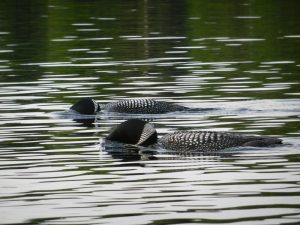Common Loon Phenophase Definitions
Directions: As you report on phenophase status (Y, N or ?) on the datasheets, refer to the definitions on this sheet to find out what you should look for, for each phenophase in each species. To report the intensity of the phenophase, choose the best answer to the question below the phenophase, if one is included.

Activity
Active individuals: One or more individuals are seen moving about or at rest.
Feeding: One or more individuals are seen feeding. If possible, record the name of the species or substance being eaten or describe it in the comments field.
Calls or song: One or more individuals are heard calling or singing. Listen to the calls of the loon.
Territorial individuals: One or more individuals are seen or heard defending a territory. This may be indicated by calls or song used as part of a territorial proclamation, chasing of an individual of the same species from a breeding area (but do not confuse this with courtship behavior, which in some species may involve chasing), or calls or displays directed at individuals of the same or a different species to defend a feeding area.

Reproduction
Courtship: A male and female are seen near one another and are engaged in courtship behavior. Do not include male displays in the absence of a female.
Mating: A male and female are seen coupled in a mating position, usually with the male on top of the female.
Nest building: One or more adults are seen constructing a nest or carrying nesting material.
Occupied nest: One or more adults are seen sitting on a nest, entering or leaving a nest site under circumstances indicating its use for nesting (including nest defense behavior), or live eggs or nestlings are seen in a nest.
Development

Downy young: One or more loon chicks are seen covered with fluffy down feathers and without any smooth contour (adult) feathers. Down may be darker (‘natal down” like in the pictures to the right) which means that the chicks are 0-2 weeks old. They can also be lighter brown, which means the chicks are 2-4 weeks old. Chicks younger than 10 days old ride on their parent’s back.

Partially-fledged young: One or more young are seen with a mix of both fluffy down and smooth contour feathers, often having an unkempt or ragged appearance. These chicks are typically 4-10 weeks of age. Towards the end of this stage chicks will be attempting to fly.
Fledged young: One or more young are seen covered with smooth contour feathers without any fluffy, natal down feathers. This includes young that can fly, young that are incapable of sustained flight, and young which are still dependent on adults.

Dead nestlings or young: One or more dead nestlings or young are seen, including those found on roads.
Dead individuals: One or more dead individuals are seen, including those found on roads.
Method
Individuals at a feeding station: One or more individuals are seen visiting a feeder, feeding station, or food placed by a person.
